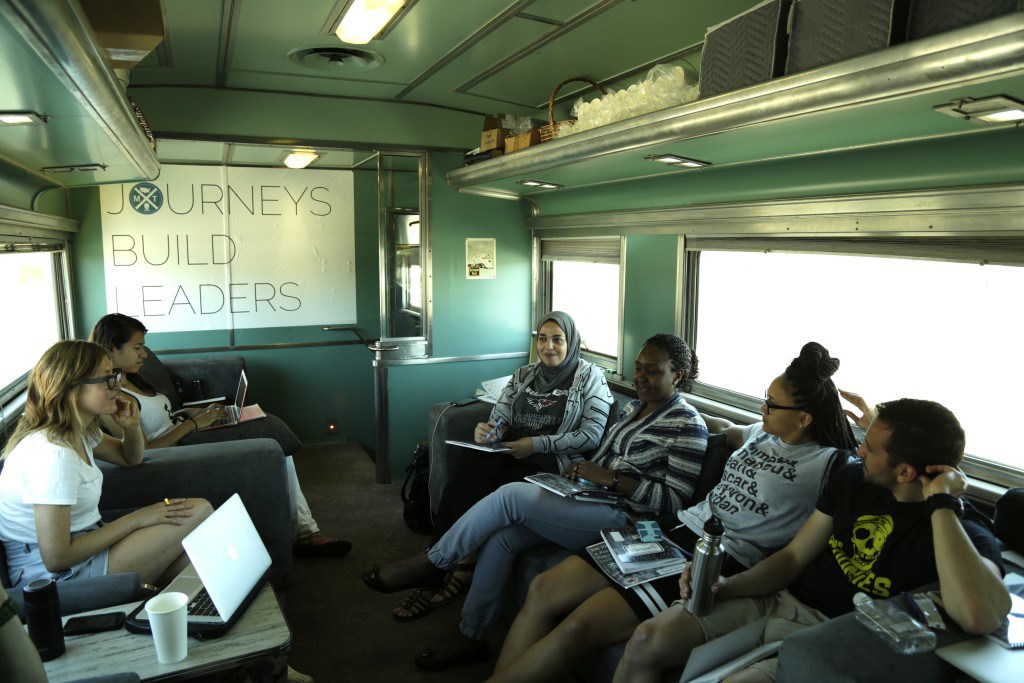If life is a journey, The Millennial Trains Project is one train I’d like to board. This train brings together people from very different backgrounds and teaches them how to take charge of their own destinies. The Trains Project is happening all over the globe.
I love the idea behind this entrepreneur-inspired effort. I love the idea that we can muster our creativity, but not have to go it alone. How much fun it would be to ride a train with other folks intent on the same mission–caregiving, let’s say. But in this newspaper article, the riders on the train were learning how to run a business.
The Millennial Trains Project repurposes trains as platforms for inclusive innovation. (Photo: Millennial Trains Project) Today, in Washington, DC, the White House is hosting its first-ever White House Demo Day to spotlight entrepreneurs from diverse backgrounds and platforms for inclusive innovation designed to help them move forward. The Millennial […]
Click here to view original web page at voices.nationalgeographic.com
Amtrak’s Train Residency Program
In 2014, Amtrak decided to use its trains for an #AmtrakResidency. The recipient of the first Amtrak writer’s residency, Jessica Gross, published “Writing the Lakeshore Limited” in The Paris Review. She compared a train ride to a writer’s garret. In the time bracketed by the beginning and end of the journey, she says a writer can dip into her subconscious. And, here’s a line I really like. “Train time is found time.”
Her essay brought so much positive attention to Amtrak that they expanded the residency and chose twenty-four writers to ride long distance trains. A few have begun to file their reports.
The contrast between The Millennial Trains Project and the Amtrak Residency couldn’t be more stark. In the first, people come together. In the latter, each writer hides away in a little compartment. To get the writing done, authors need time alone, but like anyone else, we need moments of connection and joy. As I write this, I’m thinking about a quote from Anne Morrow Lindberg: “Joy can spring like a flower, even from the cliffs of despair.”
And, I think there’s an analogy to be made for caregivers, too. So often caregivers are isolated. If it were easier to come together, it might make things easier.
Transported by Joy
A few years back, I heard author Barbara Ehrenreich speak at the Chicago Humanities Festival. In 2007 she’d published her nonfiction book, Dancing In The Streets. Just prior to her speaking engagement, she’d published Bright-sided: How the Relentless Promotion of Positive Thinking Has Undermined America. In both books she talks about our human need for intense, collective joy.
Our culture gives us few opportunities to experience rituals that connect us to one another. Sure, we have our electronic devices. We can create virtual communities, but those connections can’t replicate in-person contact. Nothing can equal the moment you’re standing next to a stranger, feeling their body-heat, and knowing the smile on their face is mirrored on your own.
I’ve had that experience very occasionally in my life. When I was in my thirties and on safari in northern Kenya, I found myself at a mission church. It was Sunday, I hadn’t been to mass in years, and I expected to be bored. Instead, When the Turkana tribespeople, wrapped in their white robes, began an a capella rendition of “Kumbayaa,” I wiped tears from my eyes. It was the song Joan Baez had sung at Stanford’s Frost Amphitheater, the song from the Poor People’s March On Washington. And, there I was, singing the same song, halfway around the world.
Moments like this take us beyond our own navel-gazing and daily worries. There’s no way to stand there stiffly, hands at your sides. You have to join in!
Here’s Barbara Ehrenreich herself. What a fantastic speech she gave. I hope you like it, too, and I’d love to know if YOU’VE had experiences like this–moments when the boundary between you and the rest of humanity just dissolves. Please leave comments below.
